Neff C17MR02.0B User Manual
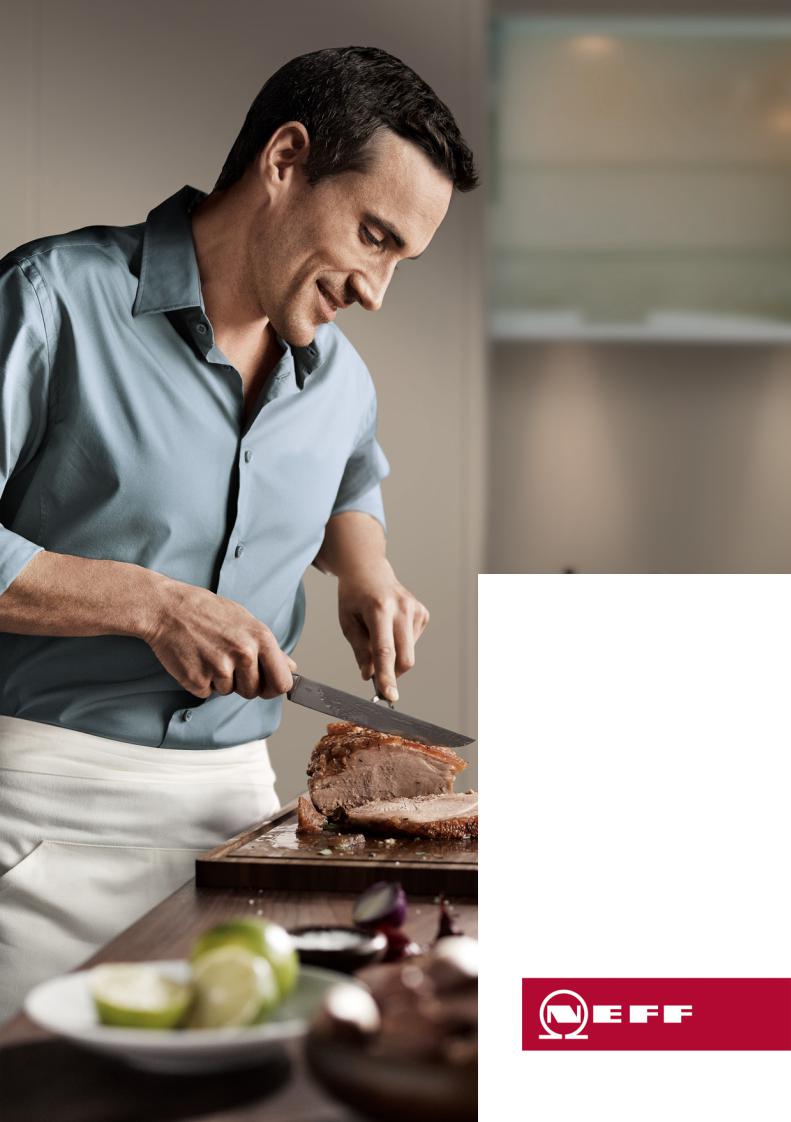
Built-in oven
[en] INSTRUCTION MANUAL
C17MR02.0B

Table of contents
(Important safety information . . . . . . . . . . . . . . . 4
General information . . . . . . . . . . . . . . . . . . . . . . . . . . . 4 Microwave . . . . . . . . . . . . . . . . . . . . . . . . . . . . . . . . . . 5
]Causes of damage . . . . . . . . . . . . . . . . . . . . . . . . 6
General information . . . . . . . . . . . . . . . . . . . . . . . . . . . 6 Microwave . . . . . . . . . . . . . . . . . . . . . . . . . . . . . . . . . . 7
7Environmental protection . . . . . . . . . . . . . . . . . . 7
Saving energy . . . . . . . . . . . . . . . . . . . . . . . . . . . . . . . 7 Environmentally-friendly disposal . . . . . . . . . . . . . . . . . 8
*Getting to know your appliance . . . . . . . . . . . . . 9
Control panel . . . . . . . . . . . . . . . . . . . . . . . . . . . . . . . . 9 Controls . . . . . . . . . . . . . . . . . . . . . . . . . . . . . . . . . . . . 9 Main menu . . . . . . . . . . . . . . . . . . . . . . . . . . . . . . . . . 10 Menu for the types of heating . . . . . . . . . . . . . . . . . . 10 Cooking compartment functions . . . . . . . . . . . . . . . . 10
_Accessories . . . . . . . . . . . . . . . . . . . . . . . . . . . . 11
Accessories included . . . . . . . . . . . . . . . . . . . . . . . . . 11 Inserting accessories . . . . . . . . . . . . . . . . . . . . . . . . . 11 Optional accessories . . . . . . . . . . . . . . . . . . . . . . . . . 12
KBefore using for the first time. . . . . . . . . . . . . . 12
Initial use . . . . . . . . . . . . . . . . . . . . . . . . . . . . . . . . . . 12 Cleaning the cooking compartment . . . . . . . . . . . . . . 12 Cleaning the accessories. . . . . . . . . . . . . . . . . . . . . . 13
1Operating the appliance . . . . . . . . . . . . . . . . . . 13
Switching the appliance on and off . . . . . . . . . . . . . . 13 Setting and starting the appliance operation . . . . . . . 13 Changing or cancelling the appliance operation . . . . 14 Heating up the appliance quickly . . . . . . . . . . . . . . . . 14
OTime-setting options . . . . . . . . . . . . . . . . . . . . . 14
Showing and hiding the time-setting options . . . . . . . 14 Setting the timer . . . . . . . . . . . . . . . . . . . . . . . . . . . . . 14 Setting the cooking time . . . . . . . . . . . . . . . . . . . . . . 15 Start delay – "Ready at" . . . . . . . . . . . . . . . . . . . . . . . 15 Checking, changing or deleting settings . . . . . . . . . . 15
AChildproof lock. . . . . . . . . . . . . . . . . . . . . . . . . . 15
Automatic childproof lock . . . . . . . . . . . . . . . . . . . . . 15 One-time childproof lock . . . . . . . . . . . . . . . . . . . . . . 16
^Microwave . . . . . . . . . . . . . . . . . . . . . . . . . . . . . . 16
Cookware. . . . . . . . . . . . . . . . . . . . . . . . . . . . . . . . . . 16 Microwave power settings . . . . . . . . . . . . . . . . . . . . . 17 Setting the microwave . . . . . . . . . . . . . . . . . . . . . . . . 17 Setting the microwave to combi-mode . . . . . . . . . . . . 18
en
QBasic settings. . . . . . . . . . . . . . . . . . . . . . . . . . . 18
Changing the basic settings . . . . . . . . . . . . . . . . . . . .18 List of basic settings. . . . . . . . . . . . . . . . . . . . . . . . . .18 Setting favourites . . . . . . . . . . . . . . . . . . . . . . . . . . . .19
DCleaning agent . . . . . . . . . . . . . . . . . . . . . . . . . . 19
Suitable cleaning agents . . . . . . . . . . . . . . . . . . . . . .19 Keeping the appliance clean . . . . . . . . . . . . . . . . . . .20
pRails. . . . . . . . . . . . . . . . . . . . . . . . . . . . . . . . . . . 21
Detaching and refitting the rails . . . . . . . . . . . . . . . . .21
qAppliance door . . . . . . . . . . . . . . . . . . . . . . . . . . 22
Removing the door cover . . . . . . . . . . . . . . . . . . . . . .22 Removing and fitting the door panels. . . . . . . . . . . . .23
3Trouble shooting . . . . . . . . . . . . . . . . . . . . . . . . 24
Fault table. . . . . . . . . . . . . . . . . . . . . . . . . . . . . . . . . .24 Maximum operating time exceeded . . . . . . . . . . . . . .25 Cooking compartment bulbs . . . . . . . . . . . . . . . . . . .25
4Customer service . . . . . . . . . . . . . . . . . . . . . . . . 25
E number and FD number . . . . . . . . . . . . . . . . . . . . .25
PProgrammes . . . . . . . . . . . . . . . . . . . . . . . . . . . . 26
Information on the settings . . . . . . . . . . . . . . . . . . . . .26 Selecting a dish . . . . . . . . . . . . . . . . . . . . . . . . . . . . .26 Setting the programme. . . . . . . . . . . . . . . . . . . . . . . .26
JTested for you in our cooking studio . . . . . . . . 27
Silicone moulds . . . . . . . . . . . . . . . . . . . . . . . . . . . . .27 Baking . . . . . . . . . . . . . . . . . . . . . . . . . . . . . . . . . . . .27 Roasting and braising. . . . . . . . . . . . . . . . . . . . . . . . .30 Grilling . . . . . . . . . . . . . . . . . . . . . . . . . . . . . . . . . . . .32 Convenience products . . . . . . . . . . . . . . . . . . . . . . . .35 Microwave . . . . . . . . . . . . . . . . . . . . . . . . . . . . . . . . .37 Yogurt. . . . . . . . . . . . . . . . . . . . . . . . . . . . . . . . . . . . .39 Eco heating type. . . . . . . . . . . . . . . . . . . . . . . . . . . . .39 Acrylamide in foodstuffs . . . . . . . . . . . . . . . . . . . . . . .40 Drying . . . . . . . . . . . . . . . . . . . . . . . . . . . . . . . . . . . . .40 Preserving . . . . . . . . . . . . . . . . . . . . . . . . . . . . . . . . .41 Defrosting . . . . . . . . . . . . . . . . . . . . . . . . . . . . . . . . . .42 Heating food in a microwave . . . . . . . . . . . . . . . . . . .43 Test dishes . . . . . . . . . . . . . . . . . . . . . . . . . . . . . . . . .45
Additional information on products, accessories, replacement parts and services can be found at
www.neff-international.com and in the online shop www.neff-eshop.com
3

en Important safety information
(Important safety information
General information :Warning
Risk of fire!
■ Combustible items stored in the cooking compartment may catch fire. Never store combustible items in the cooking compartment. Never open the appliance door if there is smoke inside. Switch off the appliance and unplug it from the mains or switch off the circuit breaker in the fuse box.
■ Loose food remnants, fat and meat juices may catch fire. Before using the appliance, remove the worst of the food remnants from the cooking compartment, heating elements and accessories.
■ A draught is created when the appliance door is opened. Greaseproof paper may come into contact with the heating element and catch fire. Do not place greaseproof paper loosely over accessories during preheating. Always weight down the greaseproof paper with a dish or a baking tin. Only cover the surface required with greaseproof paper. Greaseproof paper must not protrude over the accessories.
:Warning
Risk of burns!
■ The appliance becomes very hot. Never touch the interior surfaces of the cooking compartment or the heating elements. Always allow the appliance to cool down. Keep children at a safe distance.
■ Accessories and ovenware become very hot. Always use oven gloves to remove accessories or ovenware from the cooking compartment.
■ Alcoholic vapours may catch fire in the hot cooking compartment. Never prepare food containing large quantities of drinks with a high alcohol content. Only use small quantities of drinks with a high alcohol content. Open the appliance door with care.
:Warning
Risk of scalding!
■ The accessible parts become hot during operation. Never touch the hot parts. Keep children at a safe distance.
■When you open the appliance door, hot steam can escape. Steam may not be visible, depending on its temperature. When opening, do not stand too close to the appliance. Open the appliance door carefully. Keep children away.
■Water in a hot cooking compartment may create hot steam. Never pour water into the hot cooking compartment.
:Warning
Risk of injury!
■ Scratched glass in the appliance door may develop into a crack. Do not use a glass scraper, sharp or abrasive cleaning aids or detergents.
■ The hinges on the appliance door move when opening and closing the door, and you may be trapped. Keep your hands away from the hinges.
:Warning
Risk of electric shock!
■ Incorrect repairs are dangerous. Repairs may only be carried out and damaged power cables replaced by one of our trained after-sales technicians. If the appliance is defective, unplug the appliance from the mains or switch off the circuit breaker in the fuse box. Contact the aftersales service.
■ The cable insulation on electrical appliances may melt when touching hot parts of the appliance. Never bring electrical appliance cables into contact with hot parts of the appliance.
■ Do not use any high-pressure cleaners or steam cleaners, which can result in an electric shock.
■ A defective appliance may cause electric shock. Never switch on a defective appliance. Unplug the appliance from the mains or switch off the circuit breaker in the fuse box. Contact the after-sales service.
:Warning
Hazard due to magnetism!
Permanent magnets are used in the control panel or in the control elements. They may affect electronic implants, e.g. heart pacemakers or insulin pumps. Wearers of electronic implants must stay at least 10 cm away from the control panel.
4

Microwave :Warning
Risk of fire!
■ Using the appliance for anything other than its intended purpose is dangerous and may cause damage.
The following is not permitted: drying out food or clothing, heating slippers, grain or cereal pillows, sponges, damp cleaning cloths or similar.
For example, heated slippers and grain or cereal pillows may catch fire, even several hours after they have been heated.The appliance must only be used for the preparation of food and drinks.
■ Food may catch fire. Never heat food in heat-retaining packages.
Do not leave food heating unattended in containers made of plastic, paper or other combustible materials.
Do not select a microwave power or time setting that is higher than necessary. Follow the information provided in this instruction manual.
Never use the microwave to dry food. Never defrost or heat food with a low water content, e.g. bread, at too high a microwave power or for too long.
■ Cooking oil may catch fire. Never use the microwave to heat cooking oil on its own.
:Warning
Risk of explosion!
Liquids and other food may explode when in containers that have been tightly sealed. Never heat liquids or other food in containers that have been tightly sealed.
:Warning
Risk of burns!
■ Foods with peel or skin may burst or explode during, or even after, heating. Never cook eggs in their shells or reheat hard-boiled eggs. Never cook shellfish or crustaceans. Always prick the yolk when baking or poaching eggs. The skin of foods that have a peel or skin, such as apples, tomatoes, potatoes and sausages, may burst. Before heating, prick the peel or skin.
■ Heat is not distributed evenly through baby food. Never heat baby food in closed containers. Always remove the lid or teat. Stir or shake well after the food has been heated. Check the temperature of the food before it is given to the child.
Important safety information en
■Heated food gives off heat. The ovenware may become hot. Always use oven gloves to remove ovenware or accessories from the cooking compartment.
■Airtight packaging may burst when food is heated. Always observe the instructions on the packaging. Always use oven gloves to remove dishes from the cooking compartment.
■The accessible parts become very hot when in operation. Never touch hot parts. Keep children at a safe distance.
■Using the appliance for anything other than its intended purpose is dangerous.
You are not permitted to use it to dry food or clothing or to warm slippers, grain or cereal pillows, sponges, damp cleaning cloths or the like.
This is because, for instance, overheated slippers, grain or cereal pillows, sponges and damp cleaning cloths, etc., may cause burns to the skin.
:Warning
Risk of scalding!
■ There is a possibility of delayed boiling when a liquid is heated. This means that the liquid reaches boiling temperature without the usual steam bubbles rising to the surface. Even if the container only vibrates a little, the hot liquid may suddenly boil over and spatter. When heating, always place a spoon in the container. This will prevent delayed boiling.
:Warning
Risk of injury!
■ Unsuitable ovenware may crack. Porcelain or ceramic ovenware can have small perforations in the handles or lids. These perforations conceal a cavity below. Any moisture that penetrates this cavity could cause the ovenware to crack. Only use microwave-safe ovenware.
5

en Causes of damage
■If using the appliance in microwave mode only, placing cookware and containers made of metal inside the appliance may cause sparks when the appliance is operating. This will damage the appliance. Never use metal containers when using the appliance in microwave mode only.Use only microwave-safe cookware or, alternatively, the microwave in combination with a type of heating.
:Warning
Risk of electric shock!
The appliance is a high-voltage appliance. Never remove the casing.
:Warning
Risk of serious damage to health!
■ The surface of the appliance may become damaged if it is not cleaned properly. Microwave energy may escape. Clean the appliance on a regular basis, and remove any food residue immediately. Always keep the cooking compartment, door seal, door and door stop clean.
■ Microwave energy may escape if the cooking compartment door or the door seal is damaged. Never use the appliance if the cooking compartment door, the door seal or the plastic door frame is damaged. Call the after-sales service.
■ Microwave energy will escape from appliances that do not have any casing. Never remove the casing. For any maintenance or repair work, contact the after-sales service.
]Causes of damage
General information
Caution!
■ Accessories, foil, greaseproof paper or ovenware on the cooking compartment floor: do not place accessories on the cooking compartment floor. Do not cover the cooking compartment floor with any sort of foil or greaseproof paper. Do not place ovenware on the cooking compartment floor if a temperature of over 50 ºC has been set. This will cause heat to accumulate. The baking and roasting times will no longer be correct and the enamel will be damaged.
■ Aluminium foil: Aluminium foil in the cooking compartment must not come into contact with the door glass. This could cause permanent discolouration of the door glass.
■ Water in a hot cooking compartment: do not pour water into the cooking compartment when it is hot. This will cause steam. The temperature change can cause damage to the enamel.
■ Moisture in the cooking compartment: Over an extended period of time, moisture in the cooking compartment may lead to corrosion. Allow the cooking compartment to dry after use. Do not keep moist food in the closed cooking compartment for extended periods of time. Do not store food in the cooking compartment.
■ Cooling with the appliance door open: Following operation at high temperatures, only allow the cooking compartment to cool down with the door closed. Do not trap anything in the appliance door. Even if the door is only left open a crack, the front of nearby furniture may become damaged over time. Only leave the cooking compartment to dry with the door open if a lot of moisture was produced whilst the oven was operating.
■ Fruit juice: when baking particularly juicy fruit pies, do not pack the baking tray too generously. Fruit juice dripping from the baking tray leaves stains that cannot be removed. If possible, use the deeper universal pan.
■ Extremely dirty seal: If the seal is very dirty, the appliance door will no longer close properly during operation. The fronts of adjacent units could be damaged. Always keep the seal clean.
■ Appliance door as a seat, shelf or worktop: Do not sit on the appliance door, or place or hang anything on it. Do not place any cookware or accessories on the appliance door.
■ Inserting accessories: depending on the appliance model, accessories can scratch the door panel when closing the appliance door. Always insert the accessories into the cooking compartment as far as they will go.
■ Carrying the appliance: do not carry or hold the appliance by the door handle. The door handle cannot support the weight of the appliance and could break.
6
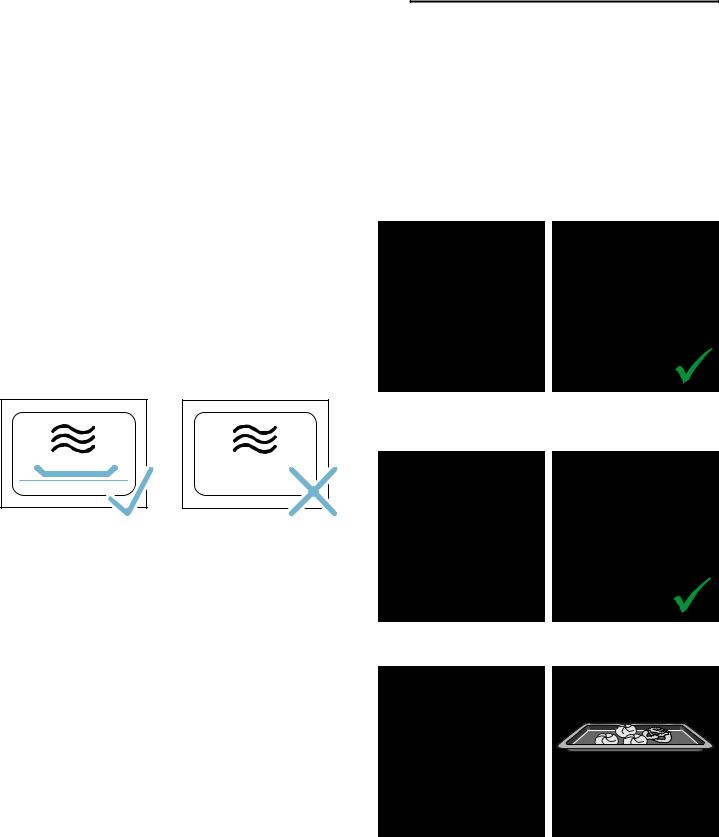
Microwave
Caution!
■ Creation of sparks: Metal – e.g. a spoon in a glass – must be kept at least 2 cm from the cooking compartment walls and the inside of the door. Sparks can irreparably damage the glass on the inside of the door.
■ Combining accessories: Do not combine the wire rack with the universal pan. Sparks may be created if they are inserted directly on top of one another. Only insert them into their own shelf level.
■ Microwave only: The universal pan and baking tray are unsuitable when using the microwave only. If you use either of these, this may create sparks, which may damage the cooking compartment. Place cookware on the wire rack provided, or place it in the microwave and set a type of heating.
■ Foil containers: Do not use foil containers in the appliance. They damage the appliance by producing sparks.
■ Operating the microwave without food: Operating the appliance without food in the cooking compartment may lead to overloading. Never switch on the microwave unless there is food inside. The short crockery test is the exception to this rule.
~ "Microwave" on page 16
■ Microwave popcorn: Never set the microwave output too high. Use a maximum microwave output of 600 watts. Always place the popcorn bag on a glass plate. The door panels may jump if overloaded.
Environmental protection en
7Environmental protection
Your new appliance is particularly energy-efficient. Here you can find tips on how to save even more energy when using the appliance, and how to dispose of your appliance properly.
Saving energy
■Only preheat the appliance if this is specified in the recipe or in the tables in the operating instructions.
■Leave frozen food to defrost before placing it in the cooking compartment.
■Use baking tins that are dark-coloured, painted black or have an enamel coating. These absorb the heat particularly well.
■Remove any unnecessary accessories from the cooking compartment.
■Open the appliance door as infrequently as possible when the appliance is in use.
7

en Environmental protection
■It is best to bake several cakes one after the other. The cooking compartment stays warm. This reduces the baking time for the second cake. You can place two cake tins next to each other in the cooking compartment.
■For longer cooking times, you can switch the appliance off 10 minutes before the end of the cooking time and use the residual heat to finish cooking.
Environmentally-friendly disposal
Dispose of packaging in an environmentally-friendly manner.
This appliance is labelled in accordance with European Directive 2012/19/EU concerning used electrical and electronic appliances (waste electrical and electronic equipment - WEEE). The guideline determines the framework for the return and recycling of used appliances as applicable throughout the EU.
8
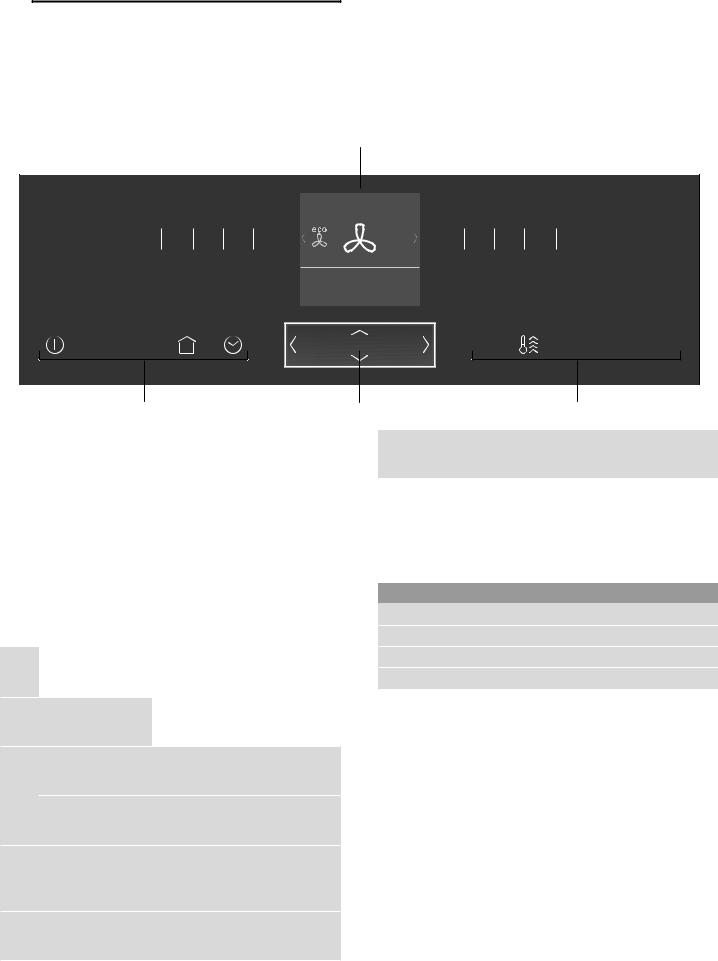
*Getting to know your appliance
In this chapter, we will explain the indicators and controls. You will also find out about the various functions of your appliance.
Getting to know your appliance en
Note: Depending on the appliance model, individual details and colours may differ.
Control panel
In the control panel, set the appliance's different functions. The current settings are shown on the display.
|
|
|
|
|
|
+RW DLU |
|
|
|
³ ± Å |
Å |
µ Ç Ý |
||
|
& |
|
|
|
|
|
|
|
|
|
|
|
|
|
( Display |
# |
Start/Stop |
Starting or stopping the operation |
|
0 Touch buttons |
||||
|
|
~"Setting and starting the |
||
8 ShiftControl control |
|
|
||
|
|
appliance operation" on page 13 |
||
Controls |
ShiftControl control |
|
||
Use the ShiftControl control element to navigate |
||||
Use the controls to set your appliance simply and |
||||
through the lines on the display and select the settings. |
||||
directly. |
Settings that you can change have left and right |
|||
Touch buttons |
arrows '. |
|
||
|
|
|
||
There are sensors under the touch buttons. Touch on the corresponding touch button to select a function.
Touch button |
Use |
|
# |
on/off |
Switching the appliance on or |
|
|
off~"Switching the appliance on |
|
|
and off" on page 13 |
0 |
Main menu |
Selecting operating modes and set- |
|
|
tings ~"Setting and starting the |
|
|
appliance operation" on page 13 |
3 |
Time-setting options |
Setting the timer, cooking time, or |
|
|
"Ready at" start delay ~"Time- |
|
|
setting options" on page 14 |
|
Childproof lock |
Activating or deactivating the child- |
|
|
proof lock ~"Childproof lock" |
|
|
on page 15 |
! |
Information |
Displaying further information |
|
|
Displaying the current temperature |
|
|
~"Setting and starting the |
|
|
appliance operation" on page 13 |
° |
Rapid heating |
Activating or deactivating the "Rapid |
|
|
heating" function ~"Heating up the |
appliance quickly" on page 14
Button |
|
Use |
( |
Left |
Navigates to the left on the display |
) |
Right |
Navigates to the right on the display |
% |
Up |
Navigates upwards on the display |
& |
Down |
Navigates downwards on the display |
Note: You can also scroll through the settings values quickly by pressing and holding a button. As soon as you release the button, you stop scrolling through the values quickly.
9

en Getting to know your appliance
Main menu
Touch the 0 touch button to access the main menu.
Menu Use
¢Types of heating
Selecting the required type of heating and temperature for your dish ~"Switching the appliance on and off" on page 13
•Microwave
You can use the microwave to cook, heat up or defrost your dishes more quickly.~"Microwave" on page 16
¡Microwave combination
You can also use this to switch on a type of heating on the microwave.~"Microwave" on page 16
±Microwave programmes
You can use these to prepare food using the microwave.~"Programmes" on page 26
"Basic settings
You can adapt your appliance's basic settings to suit your needs.~"Basic settings" on page 18
Menu for the types of heating
Your appliance has different types of heating. After switching on the appliance, you are taken directly to the menu for the types of heating.
Type of heating |
Temperature |
Use |
|
|
|
|
|
‚ |
Hot air |
30 - 275 °C |
For baking and cooking on one or more levels. |
|
|
|
The fan distributes the heat from the ring heating element in the back panel |
|
|
|
evenly around the cooking compartment. |
‡ |
Circo-roasting |
50 - 250 °C |
For roasting poultry, whole fish and larger pieces of meat. |
|
|
|
The grill element and the fan switch on and off alternately. The fan circulates the |
|
|
|
hot air around the food. |
ˆ |
Full-surface grill |
50 - 290 °C |
For grilling flat items, such as steaks or sausages, for making toast, and for au gra- |
|
|
tin dishes. |
|
|
|
|
The whole area below the grill element becomes hot. |
‰ |
Centre-area grill |
50 - 290 °C |
For grilling small amounts of steaks or sausages, for making toast, and for au gra- |
|
|
tin dishes. |
|
|
|
|
The centre area under the grill heating element becomes hot. |
¯ |
Plate warming |
30-70 °C |
For preheating ovenware. |
ž |
Hot air eco |
30 - 275 °C |
For gentle cooking of selected dishes on one level without preheating. |
|
|
|
The fan distributes the heat from the ring heating element in the back panel |
|
|
|
around the cooking compartment. |
· |
Dry appliance |
150 °C |
Dry the cooking compartment after using the microwave to ensure that no mois- |
|
|
ture remains. |
|
Cooking compartment functions
The functions in the cooking compartment make your appliance easier to use. This, for example, enables the cooking compartment to be well lit and a cooling fan to prevent the appliance from overheating.
Opening the appliance door
If you open the appliance door during an operation, the operation is paused. The operation continues to run when you close the door.
Interior lighting
If you open the appliance door, the interior lighting switches on. If the door remains open for longer than around 15 minutes, the lighting switches off again.
For most operating modes, the interior lighting switches on as soon as the operation is started. When the operation has finished, the lighting switches off.
Note: You can set the interior lighting not to come on during the operation in the basic settings. ~ "Basic settings" on page 18
Cooling fan
The cooling fan switches on and off as required. The hot air escapes above the door.
Caution!
Do not cover the ventilation slots. Otherwise, the appliance may overheat.
So that the cooking compartment cools down more quickly after the operation, the cooling fan continues to run for a certain period afterwards.
10
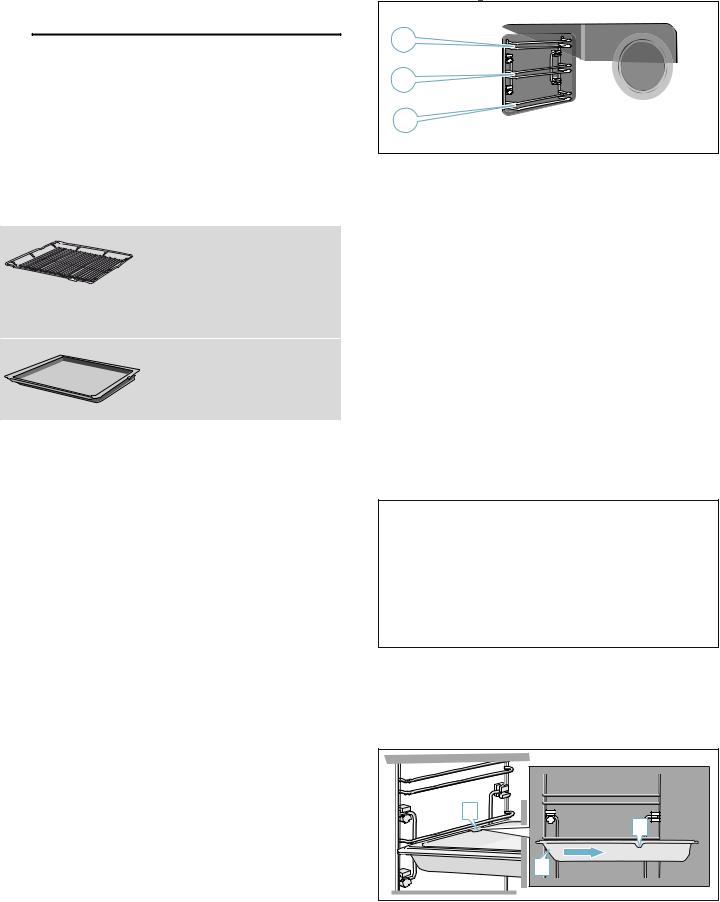
Note: You can change how long the cooling fan continues to run for in the basic settings. ~ "Basic settings" on page 18
_Accessories
Your appliance is accompanied by a range of accessories. Here, you can find an overview of the accessories included and information on how to use them correctly.
Accessories included
Your appliance is equipped with the following accessories:
Wire rack
For ovenware, cake tins and ovenproof dishes.
For roasts, grilled items and frozen meals.
The wire rack is suitable for use in the microwave.
Universal pan
For moist cakes, pastries, frozen meals and large roasts.
It can be used to catch dripping fat when you are grilling directly on the wire rack.
Only use original accessories. They are specially adapted for your appliance.
You can buy accessories from the after-sales service, from specialist retailers or online.
Note: The accessories may deform when they become hot. This does not affect their function. Once they have cooled down again, they regain their original shape.
Microwave
Only the wire rack provided is suitable when using the microwave only. If you use the universal pan or the baking tray, this may create sparks, which may damage the cooking compartment.
When using the appliance in combination with the microwave or "Dishes" mode, you can use the universal pan, baking tray or any other accessories that have been included with the appliance.
Accessories en
Inserting accessories
The cooking compartment has three shelf positions. The shelf positions are counted from the bottom up.
|
|
|
When using positions 1, 2 and 3, always insert the accessory between the two guide rods for a shelf position.
Notes
■Ensure that you always insert the accessories into the cooking compartment the right way round.
■Always insert the accessories fully into the cooking compartment so that they do not touch the appliance door.
Locking function
The accessories can be pulled out approximately halfway until they lock in place. The locking function prevents the accessories from tilting when they are pulled out. The accessories must be inserted into the cooking compartment correctly for the tilt protection to work properly.
When inserting the wire rack, ensure that the catch tappet ‚ is at the rear and is facing downwards. The lettering "microwave" must be at the front and the outer rail must face downwards ¾.
D |
D |
When inserting baking trays, ensure that the catch tappet ‚ is at the rear and is facing downwards. The
sloping edge of the accessory ƒ must be facing forwards towards the appliance door.
Example in the picture: Universal pan
D |
D |
E |
11

en Before using for the first time
Optional accessories
You can purchase optional accessories from the aftersales service and specialist retailers, or on the Internet. You will find a comprehensive range of products for your appliance in our brochures and on the Internet.
Both availability and whether it is possible to order online differ between countries. Please see your sales documents for more details.
Note: Not all optional accessories are suitable for every appliance. When purchasing, please always quote the exact designation (E no.) of your appliance.
~ "Customer service" on page 25
Accessories
Baking and roasting shelf
Baking tray
Universal pan
Baking tray, non-stick
Universal pan, non-stick
Extra-deep pan
Profi pan
Lid for the Profi pan
Pizza tray
Grill tray
Ceramic brick
Glass roasting dish, 5.1 litres
Glass pan
Steaming set for ovens
Decorative strip
KBefore using for the first time
Before you can use your new appliance, you must make some settings. You must also clean the cooking compartment and accessories.
Initial use
As soon as the appliance is connected to the power supply, the first setting "Language" appears on the display.
Setting the language
1.Use the & button to navigate to the bottom line.
2.Use the ( or ) button to select the language.
3.Use the % button to return to "Language".
4.Use the ) button to select the next setting.
Setting the time
1.Use the & button to navigate to the next line.
2.Use the ( or ) button to select the current time.
3.Press the % button.
4.Use the ) button to select the next setting.
Setting the date
1.Use the & button to navigate to the next line.
2.Use the ( or ) button to select the current day.
3.Use the % button to return to "Day".
4.Use the ) button to select the next setting.
5.Use the & button to navigate to the next line.
6.Use the ( or ) button to select the current month.
7.Use the % button to return to "Month".
8.Use the ) button to select the next setting.
9.Use the & button to navigate to the next line.
10.Use the ( or ) button to select the current year.
11.Use the % button to return to "Year".
12.Use the ) button to apply the settings. The initial use is complete.
Notes
■You can change these settings at any time in the basic settings. ~ "Basic settings" on page 18
■After connecting the appliance to the power or following a power cut, the settings for initial use are shown in the display.
Cleaning the cooking compartment
To remove the new-appliance smell, heat up the cooking compartment when it is empty and with the oven door closed.
1.Remove the accessories from the cooking compartment.
2.Remove leftover packaging, such as polystyrene pellets, from the cooking compartment.
3.Before heating the appliance, wipe the smooth surfaces in the cooking compartment with a soft, damp cloth.
12
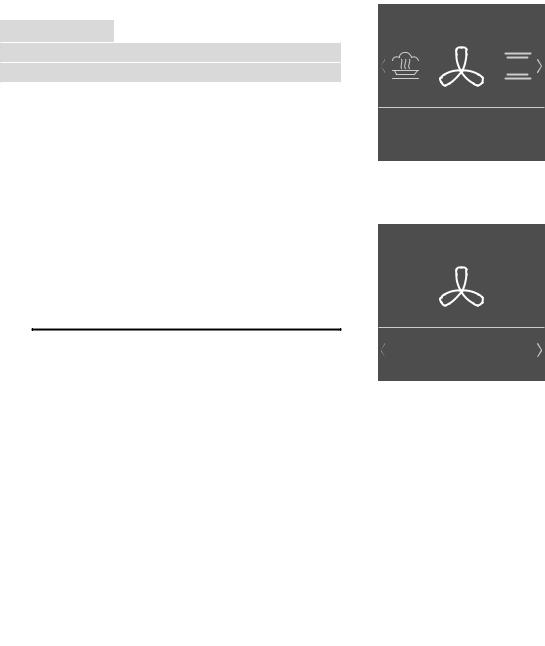
4.Use the # touch button to switch on the appliance.
5.Set the specified type of heating and temperature, then start the appliance operation. ~ "Setting and starting the appliance operation" on page 13
Settings |
|
Type of heating |
Circo-roasting ‡ |
Temperature |
250 °C |
Cooking time |
1 hour |
6.Keep the kitchen ventilated while the appliance is heating up.
7.Use the # touch button to switch off the appliance after the indicated cooking time.
8.Wait until the cooking compartment has cooled down.
9.Clean the smooth surfaces with soapy water and a dish cloth.
Cleaning the accessories
Clean the accessories thoroughly using soapy water and a dish cloth or soft brush.
1Operating the appliance
You have already learnt about the controls and how they work. Now we will explain how to set your appliance. You will learn about what happens when you switch the appliance on and off, and how to select the operating mode.
Switching the appliance on and off
Touch the # touch button to switch the appliance on or off.
After switching off the appliance, on the display you can see if the residual heat in the cooking compartment is high or low.
Display |
Meaning |
-H- |
Residual heat high (above 120 °C) |
-h- |
Residual heat low (between 60 °C and 120 °C) |
|
|
Notes
■Certain displays and notes, such as the residual heat in the cooking compartment, remain visible on the display even when the appliance is switched off.
■After an appliance operation, the cooling fan runs on audibly until the cooking compartment has been cooled as far as possible.
■Switch off your device when you do not need to use it. If no settings are applied for a long time, the appliance switches itself off automatically.
Setting and starting the appliance operation
Example: ‚ Hot air at 170 °C
Operating the appliance en
1.Touch the # touch button to switch on the appliance.
You are taken directly to the ¢ "Types of heating" menu.
+RW DLU
&
2.Use the ( or ) button to select the type of heating.
3.Use the & button to navigate to the next line.
4.Use the ( or ) button to select the temperature.
+RW DLU
&
Note: Additional settings are available, depending on the operating mode. For each further setting, use
the & button to navigate to the next line. Use the ( or ) button to select the setting.
5.Touch the # touch button to start the appliance
operation.
The heating bar and run time appear on the display.
Note: If you would like to go directly to the 0 main
menu after switching on the appliance, you can select the main menu under "Operation after switching on" in the basic settings chapter. ~ "Basic settings"
on page 18
Default values
The appliance suggests a temperature or setting for each type of heating. You can accept this value or change it in the appropriate area.
Heating bar
As soon as a type of heating has started, the heating bar appears on the display.The heating bar shows the temperature increase in the cooking compartment.
Run time
When a type of heating has been started, the run time is displayed. The run time counts upwards during the operation. You can therefore check how long the operation has already been running.
13

en Time-setting options
Displaying the current temperature
To show the current temperature on the display, press the ! touch button.
The current temperature is shown briefly only when heating up.
Further information
If the ! touch button lights up, information can be
displayed. Touch the ! touch button to do this. The information is displayed for a few seconds.
Changing or cancelling the appliance operation
Changing the appliance operation
1.Use the # button to stop the operation.
2.Use the & or % button to navigate to the line for the setting that should be changed.
3.Use the ( or ) button to change the setting.
4.Use the # touch button to start the changed operation.
Notes
■The cooling fan may continue to run while an operation is interrupted.
■After a temperature change, the paused running time continues to count. After a change in the type of heating, the running time starts again from zero.
Cancelling the appliance operation
Press and hold the # touch button until the appliance operation is cancelled.
Note: Operating modes such as the cleaning function cannot be cancelled.
Heating up the appliance quickly
You can reduce the heating time using the "Rapid heating" function.
Function |
Type of heating |
Place the food in |
|
|
the cooking |
|
|
compartment |
Rapid heating |
Hot air ‚ |
After heating |
|
|
|
Notes
■When the ° touch button lights up, the "Rapid heating" function can be activated.
■Touch the ° touch button to deactivate the "Rapid heating" function early.
Activating the "Rapid heating" function
1.Set ‚ Hot air and the temperature.
Note: Set a temperature above 100 °C to allow the appliance to preheat quickly.
2.Touch the # touch button to start the appliance operation.
3.Touch the ° touch button to activate the "Rapid heating" function.
The ° symbol appears on the display.
4.Once the set temperature has been reached, the "Rapid heating" function switches off automatically. The ° symbol disappears from the display. Place the food in the cooking compartment.
OTime-setting options
Your appliance has different time-setting options.
Time-setting option |
Use |
|
. |
Timer |
The timer functions like an egg timer. The |
|
|
appliance does not switch on and off auto- |
|
|
matically. |
+ |
Cooking time |
Once the set cooking time has elapsed, |
|
|
the appliance switches off automatically. |
* |
Ready at |
The appliance switches on automatically, |
and once the set cooking time has elapsed and the end time has passed, it switches off automatically.
Note: If you have set a time-setting option, the time interval increases if you set a higher value. Example: You can set a cooking time of up to one hour in oneminute increments; for cooking times over one hour, you can set a cooking time in five-minute increments.
Showing and hiding the time-setting options
To show or hide the time-setting options, touch the 0 touch button.
Note: After a particular length of time, the time-setting options that are shown are automatically hidden. If you have already set a cooking time, it will be applied.
PLQ_V
K_PLQ
Setting the timer
The timer can be set when the appliance is switched on or off.
1.Touch the 0 touch button.
The time-setting options are shown on the display.
2.Select the cooking time using the ) button.
Note: When the appliance is switched on, use the % button to navigate to the Timer . line and then select the cooking time using the ) button.
3.Touch the 0 touch button to start the timer.
The . symbol appears on the display.The timer counts down.
14

Note: As soon as the set time has elapsed, a signal sounds. To cancel the signal tone, touch the 0 touch button.
Setting the cooking time
Once the set cooking time has elapsed, the appliance switches off automatically. The function can only be used in combination with a type of heating.
1.Touch the # touch button.
2.Set the type of heating and temperature.
3.Touch the 0 touch button.
The time-setting options are shown in the display.
4.Use the ( or ) button to set the cooking time.
–Default value for the ( button = 10 minutes
–Default value for the ) button = 30 minutes
5.Touch the # touch button to start the set cooking time.
As soon as the cooking time has elapsed, an audible signal sounds and the appliance ends the operation
automatically. Touch the 0 touch button to end the audible signal.
Start delay – "Ready at"
The appliance switches on automatically and switches off at the preset end time.To do this, set the cooking time and determine the end time for the operation.
The start delay can only be used in combination with a type of heating.
Notes
■Ensure that food is not left in the cooking compartment for too long as it may spoil.
■It is not possible to start every type of heating with a start delay.
1.Slide food into the cooking compartment on a suitable accessory and close the appliance door.
2.Touch the # touch button.
3.Set the type of heating and temperature.
4.Touch the 0 touch button.
The time-setting options are shown on the display.
5.Select the cooking time using the ) button.
6.Use the & button to navigate to the "* Ready at" line.
7.Select the end time using the ) button.
8.Touch the # touch button.
The appliance waits until the appropriate time to start the operation.
As soon as the end time has passed, a signal sounds and the appliance stops the operation automatically. To
cancel the signal tone, touch the 0 touch button.
Checking, changing or deleting settings
1.Touch the 0 touch button.
The time-setting options are shown on the display.
2.Use the & or % button to navigate through the lines.
Childproof lock en
3.If necessary, change the setting using the ( or )
button. Set "00:00" to delete a time function. The setting is applied automatically.
AChildproof lock
Your appliance is equipped with a childproof lock so that children cannot switch it on accidentally or change any settings.
Your appliance has two different locks.
Lock |
Activate/deactivate |
Automatic childproof lock |
Via the Settings menu ~"Basic |
|
settings" on page 18 |
One-time childproof lock |
Via the 0 touch button |
|
|
Note: As soon as you activate the childproof lock, the control panel is locked. The 0 and # touch buttons
are not included.You can deactivate the childproof lock at any time.
Automatic childproof lock
The control panel is locked so that the appliance cannot be switched on. To switch it on, the automatic childproof lock must be interrupted. After the appliance operation, the control panel is locked automatically.
Activating
1.Touch the ± touch button.
2.Touch the 0 touch button.
3.Use the ( or ) button to select the "Settings".
4.Use the & button to navigate to the next line.
5.Use the ( or ) button to select "Automatic childproof lock".
6.Use the & button to navigate to the next line.
7.Use the ( or ) button to select "Activated".
8.Touch the 0 touch button.
9.Use the & button to navigate to the next line to save
the setting.
The "Automatic childproof lock" is activated. The 1 symbol appears on the display after switching off the appliance.
Cancelling
1.Press and hold the 0 touch button until "Childproof lock deactivated" appears on the display.
2.Touch the ± touch button.
3.Switch on the required appliance operation.
Deactivating
1.Press and hold the 0 touch button until "Childproof lock deactivated" appears on the display.
2.Touch the ± touch button.
3.Touch the 0 touch button.
4.Use the ( or ) button to select the "Settings".
5.Use the & button to navigate to the next line.
6.Use the ( or ) button to select "Automatic childproof lock".
15
